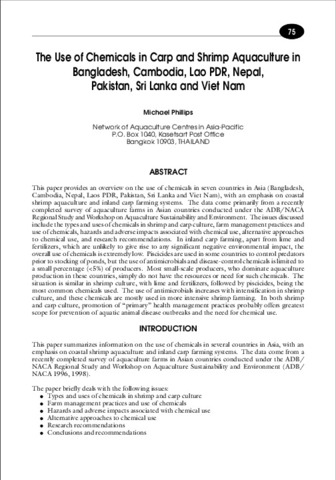The use of chemicals in carp and shrimp aquaculture in Bangladesh, Cambodia, Lao PDR, Nepal, Pakistan, Sri Lanka and Viet Nam
Share
Abstract
This paper provides an overview on the use of chemicals in seven countries in Asia (Bangladesh, Cambodia, Nepal, Laos PDR, Pakistan, Sri Lanka and Viet Nam), with an emphasis on coastal shrimp aquaculture and inland carp farming systems. The data come primarily from a recently completed survey of aquaculture farms in Asian countries conducted under the ADB/NACA Regional Study and Workshop on Aquaculture Sustainability and Environment. The issues discussed include the types and uses of chemicals in shrimp and carp culture, farm management practices and use of chemicals, hazards and adverse impacts associated with chemical use, alternative approaches to chemical use, and research recommendations. In inland carp farming, apart from lime and fertilizers, which are unlikely to give rise to any significant negative environmental impact, the overall use of chemicals is extremely low. Piscicides are used in some countries to control predators prior to stocking of ponds, but the use of antimicrobials and disease-control chemicals is limited to a small percentage (<5%) of producers. Most small-scale producers, who dominate aquaculture production in these countries, simply do not have the resources or need for such chemicals. The situation is similar in shrimp culture, with lime and fertilizers, followed by piscicides, being the most common chemicals used. The use of antimicrobials increases with intensification in shrimp culture, and these chemicals are mostly used in more intensive shrimp farming. In both shrimp and carp culture, promotion of “primary” health management practices probably offers greatest scope for prevention of aquatic animal disease outbreaks and the need for chemical use.
Suggested Citation
Phillips, M. (2000). The use of chemicals in carp and shrimp aquaculture in Bangladesh, Cambodia, Lao PDR, Nepal, Pakistan, Sri Lanka and Viet Nam. In J. R. Arthur, C. R. Lavilla-Pitogo, & R. P. Subasinghe (Eds.), Use of Chemicals in Aquaculture in Asia: Proceedings of the Meeting on the Use of Chemicals in Aquaculture in Asia, 20-22 May 1996, Tigbauan, Iloilo, Philippines (pp. 75-86). Tigbauan, Iloilo, Philippines: Aquaculture Department, Southeast Asian Fisheries Development Center.

